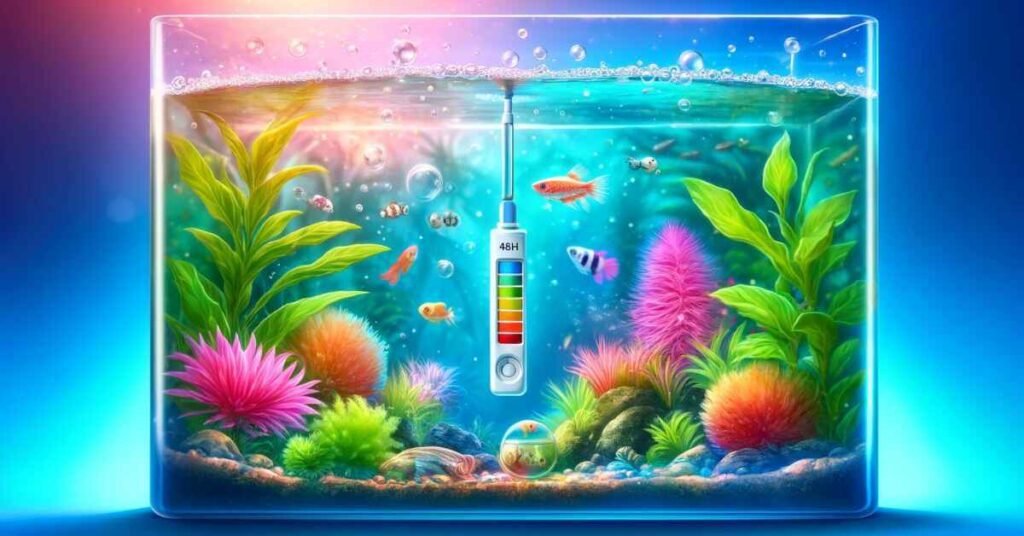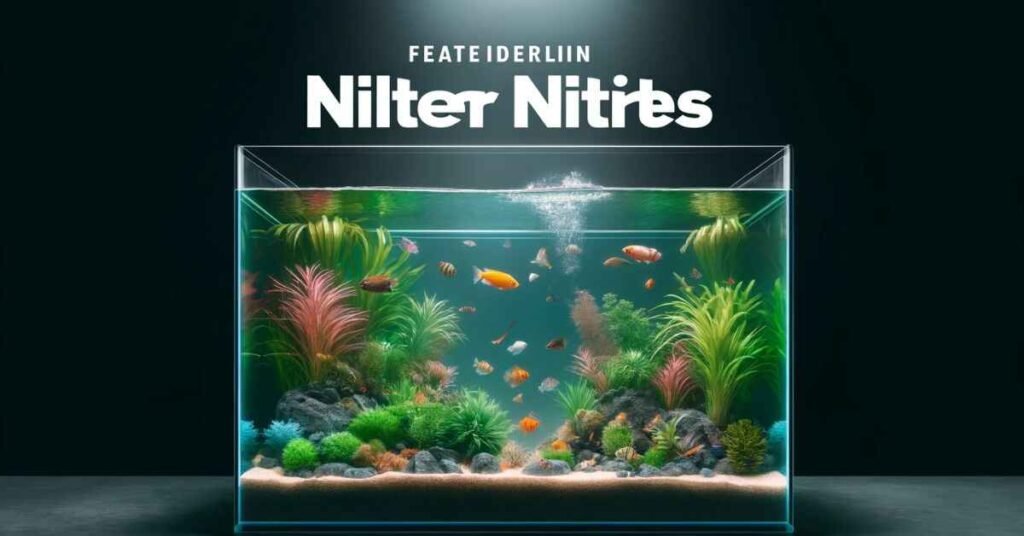Nitrite levels in your fish tank can be harmful to your fish. High levels can cause stress, illness, and even death. But you can create a safe and healthy environment for your fish. This post will explain how to lower nitrites in fish tanks. We’ll cover the basics of aquarium maintenance, including the nitrogen cycle, water changes, and filtration. Regular water changes help remove nitrites from the tank. A good filter can also help keep lower nitrites in fish tanks. By following these simple tips, you can keep your fish tank nitrite-free and your fish happy and healthy. Your fish will thrive in a safe and healthy environment.
Understanding What is Nitrites?
Nitrites can be considered an organic molecule that can be found in water basins. They appear as a by-product of the nutrient cycle, due to the excretion of waste products by microorganisms. Nitrites have a poisonous effect on fish and they dangerously affect aquatic life. It might create tension, and sickness, and sometimes end up in death. One example is that nitrites arise as the payload of the nitrogen cycle. Breathing high concentrations far beyond the limit values can cause serious harmful effects.
Through tap water or the decadence of the plants, nitrates can be formed as well. People who have an aquarium must know what nitrites are. It lessens our worries about the cleaning process and provides a safe place for fish to inhabit. We are aware of the nitrites for now we can take certain measures and lower nitrites in a fish tank.

5 Reasons for Nitrate Levels Going Up
Nitrate levels in your fish tank can rise for several reasons. Here are 5 common causes:
1. Overfeeding
Feeding your fish too much food can cause the food to deteriorate and give off nitrate into the water. Be sure to feed your fish only what they can eat in one fishing trip.
2. Infrequent Water Changes
Nitrate levels may rise to accumulate if you aren’t changing the tank water regularly. It would be a try to 25% of water change every week, for example.
3. Too Many Fish
High levels of ammonia are a result of excessive amounts of fish in the tank, which leads to a waste overload and very high nitrate levels. By the way, do not forget to provide your fish with sufficient space in the tank for them to swim and live happily.
4. Poor Filter Maintenance
When the filter is clogged or dirty, it makes work harder and causes them to miss the nitrate. Frequently change and replace the filtration media to keep your tank system in a clean state.
5. Decaying Plants
Nitrates can be released into water when dead or decaying plants decay. Get rid of any dead plants and regularly maintain your live plants by trimming and caring for them.

Strategies for Nitrite Levels Be Lower in Fish Tank
lower nitrites in fish tanks are crucial for the health and well-being of your fish.
Here are some effective strategies that will help you:
1. Regular Water Changes
Switch 25 % of the tank water every day to help remove nitrites and to prevent buildup.
2. Monitor Feeding
Do not overfeed, as too much food will decay, and nitrites released. Feed the fish only what they need to do in a couple of minutes.
3. Maintain Good Filtration
Make sure your filter will function correctly to get it done. Use a filter that can be easily removed cleaned and replaced when the filter media is too old and composting activity is lagging.
4. Add Live Plants
Live plants are known for the fact that they absorb nitrites, in doing so the level is lowered. Choose artificial plants that fit into your aquarium noise, and take care of them properly.
5. Increase Water Circulation
The water pump leads to rising oxygen levels and decreasing nitrite accumulation. Throw in powerheads or change your filter outlets.
6. Perform Regular Water Tests
Make sure the nitrite level is checked constantly to detect any changes in an early stage. Adjust your approaches as the situation requires.
7. Avoid Overcrowding
Many fish are very productive and the excess wastes they create turn nitrites into toxic chemicals. Make sure that you provide your fish with ample room to move around and grow.
8. Add Nitrite-Reducing Products
Specialized products can help with the lower nitrites in fish tanks. Be scrupulous about following directions and record results.
Is chemical filtration necessary?
Filtration with chemicals is one of the critical things that aquarium keeping depends upon. It helps to clean the water, rid of the toxic materials, and keep your fish healthy.
Yet is it still a necessity? The answer is yes! The chemical filtration process lowers nitrites in fish tanks, medications, and other impurities that might endanger your fish.
It can be used to promote and maintain good water quality by the right amount of dissolved substances which is fundamental to fish life.
You wouldn’t get far without applying chemical filtration and, as a result, your aquarium water will become insalubrious, which makes your fish sick and perhaps even dead.
Carbon-activated, a common chemical filter media, plays the role of removing ( impurities and smells from the water).
Other chemical filter types such as resins and absorbents are designed to eliminate defined chemical problems within a water system.
Chemical filtering is always used especially for tanks that are overstocked or that don’t have enough biological filtering.
Water changes every once in a while plus the chemical filtration gives extra support.
Biological filtration should not be the only choice, chemical filtration should be added when tank maintenance is done. It’s a clean and easy method to ensure your fish stays in good and upbeat conditions.
Keep in mind that chemical filtration is an important phase of keeping the environment healthy and the fish safe constantly. When you put it into practice, you as well will be rewarded for having happy and healthy fish in your tank by following the recommendation.

Safety Precautions
When you are setting up your fish tank, use safety measures as a guideline. You must switch off the power of the tank before proceeding with the cleaning or maintenance work. First of all, disconnect the filter, heater, and other devices from the electrical sources to prevent electric shock.
Wear safety gloves to make sure you don’t get cut or scratched by sharp items. Keep kids and pets out of the tank to rule out any unintended happenings.
Be alert with glass or sharp objects so you don’t get injured. Use a ladder or step stool only in urgent situations and make sure to have friends or family members holding it for you.
Don’t stoop over near the lagoon or touch the water without a support. Keep the floor in the vicinity of the fish tank dry to avoid slipping.
Apply a soft cloth or sponge to clean your tank and avoid scratching the glass by all means. An avoidance of the harsh chemicals or the abrasive cleaners that can affect your fish is a must.
Place the tank somewhere in the apartment never use it in direct sunlight or near to the heat sources. Be sure to dispose of aquarium water into the environment safely. Otherwise, the aquarium water can end up harming the environment. Dispose of all the materials used with cleaning and waste properly. By doing so we can save our health, aquarium, and nature.
Conclusion
Lower nitrites in fish tanks is a fundamental element of keeping safe habitats for fish and their ecosystems. Through mindful feeding and freshwater changes, we can avoid nitrite build-up in aquariums. Regularly maintaining the filtration system is required to remove nitrates properly. To avoid waste discharge one has to control fish population intensity. The use of plants that take out nitrite from water contributes to the maintenance of balanced water chemistry. Water parameters have to be incessantly monitored for timely lower nitrites in fish tanks.
The quick action of nitrite through proactive measures taken when nitrite levels are high is the guarantee of healthy aquatic pet life. By taking these basic yet significant measures, the habitat can be transformed into a place of harmony where fish can survive nicely. Continuous care and keen eyes for the levels of nitrites in the ecosystems of our aquariums are paramount to the long-term health of these plants and fish. Unitedly, we shall endeavor to guarantee that our finned comrades reside in a clean and happy habitat.
FAQ’s
1. Why are high nitrite levels dangerous for fish?
High nitrate levels can harm fish by reducing their ability to absorb oxygen, leading to suffocation and stress.
2. How often should I check nitrite levels?
It’s best to check nitrite levels weekly, especially in new tanks or if there are changes in the tank environment.
3. Can I use chemicals to lower nitrite levels quickly?
Chemical treatments may offer a quick fix, but it’s better to address the root causes through proper tank maintenance.
Also Must Read More: How Do I Change the Water in a Small Fish Tank?